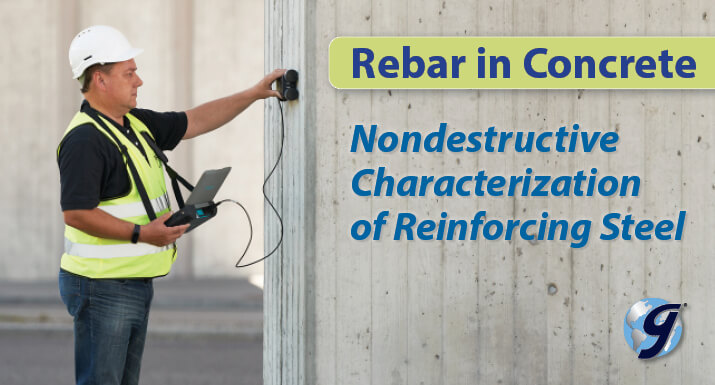
Importance of Locating Steel Reinforcement in Concrete
Accurate location and identification of embedded concrete reinforcing steel is a primary step in nondestructive evaluations of reinforced concrete structures or pavements. Likewise, if core drilling is required for the installation of utilities or to obtain concrete strength samples, accurate bar locations prevent damage to the reinforcing steel.
Finding Reinforcement in Concrete
Cover meters and rebar locators, sometimes called pachometers, are versatile devices indispensable for any organization involved in the design, construction, or testing of concrete in structures or pavements. They permit the user to quickly and economically make a structural condition assessment of reinforcing steel installations without disturbing concrete. If coring is required, they guide the location of the hole to avoid damage to rebar, post-tensioning tendons, and some embedded utilities.
Concrete cover meters and rebar locators have been used for decades for these purposes and have steadily kept pace with advances in electronics and instrument design. These devices are offered with many different levels of functionality and features to meet the needs and preferences of the user. This blog post will help you understand the equipment and what your options are for selecting the best meter for your application.
Cover Meter and Rebar Locator Applications
Primary uses for these devices center around nondestructive initial investigations, as well as preventing potential damage to reinforcing steel by identifying areas where it exists before cutting or drilling. Some examples:
- Nondestructive evaluation of the reinforcement matrix:
- Measuring the depth of concrete cover for structural compliance, corrosion resistance, and fire protection
- Ensure correct bar placement and spacing
- Measuring bar diameters to ensure compliance with design requirements
- Locate wall ties, splices, tendons, and other metal embedments
- Proper splice lengths
- Avoiding damage to reinforcing steel during penetrations by saw cutting or core drilling operations. Accidental damage to reinforcing steel can seriously compromise the integrity of a structure.
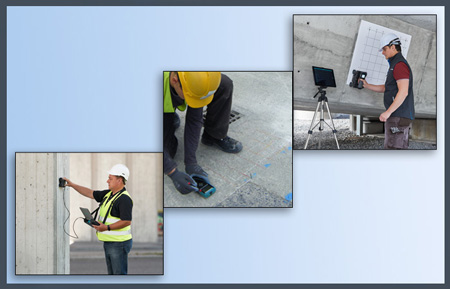
Functionality and Features
Just as there are different reasons for defining the location and characteristics of concrete reinforcing steel, there are different types of rebar locators and cover meters. The classes of instruments are not strictly limited, but there are general groupings based on function and design:
- Cover Meters perform a complete nondestructive evaluation of concrete reinforcing steel. They accurately measure the location, diameter, and embedded depth of steel reinforcing bars. A quality concrete cover meter is the best tool for assessing the integrity of the entire reinforcing steel system. Multiple pulse induction coils generate eddy current magnetic fields, inducing an opposite magnetic field on the surface of electrically conductive materials in the eddy current field. The resulting change in voltage creates a signal that can be processed to determine the location of rebar, depth of concrete cover, and rebar diameter. This method is unaffected by nonconductive materials such as concrete, wood, plastics, bricks. The measurements are also not influenced by moisture, non-metallic inclusions, or voids in the concrete. Conductive materials within the magnetic field will influence measurements.
- Rebar Locators use similar detection technology, but the apparatus is more economical, compact, and simpler to operate. Electronic signal processing is not as sophisticated, so while location accuracy and tolerance are comparable, estimations of concrete cover depth, bar diameter, and wide-area evaluations are less precise. Choose a rebar locator for frequent applications like utility penetrations or coring for concrete strength samples among closely-spaced individual bars. They can also accurately locate the exact position of embedded wall ties, wire mesh, studs, and other metal fasteners.
- Metal Detectors are effective in less demanding applications where the general locating of widely-spaced bars is sufficient. Many detectors can differentiate between ferrous and non-ferrous metals and reduce confusion in the presence of metals (i.e., copper pipes) that are not part of the reinforcement system. The lower resolution makes it harder to define exact locations and boundaries, and the detection circuitry can be subject to interference.
- Ground-Penetrating Radar (GPR) Concrete Scanner is the “New Kid on the Block." The technology has been around for some time in applications that explore subsurface soil conditions, archaeological remains, or underground utility locations. Recent advancements in frequency tuning and sensor technology have opened up the field for the nondestructive evaluation of hardened concrete. Modern concrete GPR instruments accurately locate and size large reinforcing bars as much as 2ft (610mm) below the surface. Beyond that, they form a complete representation of voids, inclusions, delamination, and utilities beneath concrete surfaces. Some models use advanced signal processing to render three-dimensional subsurface views for a clear presentation of data. It should be noted that conductive materials, other than reinforcing steel bars, located within the magnetic field will affect the accuracy of meter readings.
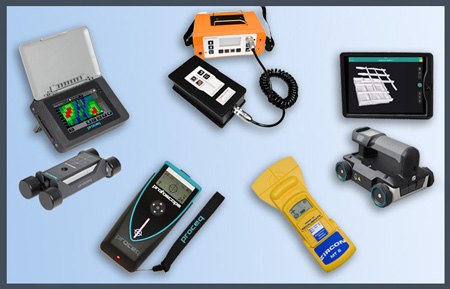
Instrument Capabilities and Performance
Measuring capabilities claimed by different manufacturers of detectors, locators, and cover meters vary widely, and it can be challenging to pin down a meaningful comparison between models. Some units claim detection at extended depths and accuracy levels, but the results may only be meaningful for large bars spaced widely apart, or at a significant reduction in accuracy tolerances. It is well worth the time for a careful review of performance specifications before making a purchase decision. The job at hand may not always require a very high degree of accuracy, but you should understand the limitations of the equipment you choose.
In ideal conditions, a high-quality eddy current cover meter accurately measures concrete cover up to 185 ±4mm (7.3 ±0.16in), and bar diameters to a tolerance of ±1 rebar size to a depth of 63mm (2.5in). So, in general, 12 or 16mm (#4 or #5) reinforcing bars can be individually located and reliably measured for cover at depths around 125 to 140mm (5 to 5.5in) and diameter to about 63mm (2.5in). Measurements may still be possible beyond these limits at reduced accuracy. Less expensive metal detectors locate various metal objects up to 152 ±25mm (6 ±1in) depths with a positional accuracy of 13mm (0.5in) and are not reliable for accurate determinations of bar size.
Modern cover meters and locators feature a wide array of technological innovations that improve accuracy, recording, reporting, and ease of use while meeting BS 1881, Part 204, and other standards. Advances in electronics allow improved accuracy, especially in installations where rebars have very close spacing. Touch-screen color displays simplify operation and display complete measurement information, including visual mapping of concrete cover with the depiction of rebar locations. Electronic data systems collect test values and locations, perform statistical analyses, and prepare reports for upload to computers and printers.
Technology advances of the probes alone have kept pace with those of the complete instruments. Specialized test probes are available to scan large areas, pinpoint individual bars in congested installations or corners or find rebars at extended depths. The probes can be mounted in small, wheeled carts for smooth, fast operation on walls or used with extension handles to scan large areas of floor slabs or ceilings with no need to bend over or climb a ladder.
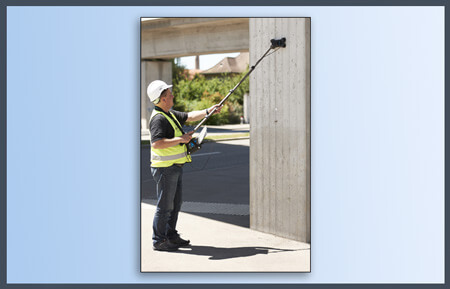
Gilson's Recommendations:
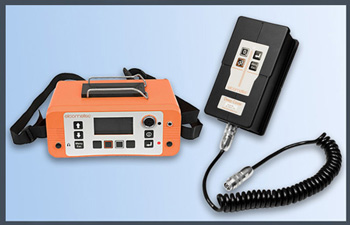 Elcometer Cover Meters
Elcometer Cover MetersAre accurate and reliable, and designed for locating the depth and placement of rebar. The 331 series has accuracy levels that exceed requirements. A backlit screen displays numeric values. Optional narrow pitch and deep-cover search heads are available, and selected models are convertible to half-cell corrosion meters.
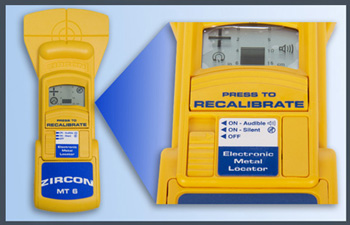 Handheld Digital Metal Detector
Handheld Digital Metal DetectorIs inexpensive and effective for the general locating of widely spaced reinforcing steel. It is best used for preliminary scanning to detect the location and approximate depth of rebar, metal pipe, conduit, and most non-metallic construction materials. They can be a convenient everyday component of your field inspection kit.
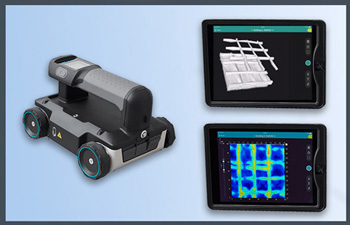 Ground Penetrating Radar (GPR) Concrete Scanner
Ground Penetrating Radar (GPR) Concrete ScannerIs a handheld ground-penetrating radar unit. Allows for a quick and reliable assessment using Stepped Frequency Continuous Wave (SFCW) technology The Proceq GP8000 GPR Live is available in two options with different levels of features, functionality, and data storage.
Learn more about nondestructive testing equipment for concrete.
Gilson Is Here to Help
Contact our testing experts for more information or to discuss your testing application.
Testing Resources
Standard Test Methods, Specifications, and Practices
Individual test methods and specifications referenced in our product descriptions, blog articles, and videos are available for review or purchase from the professional organizations noted.
- ASTM International (American Society for Testing and Materials)
- AASHTO (American Association of State Highway and Transportation Officials)
- ACI (American Concrete Institute)
- State DOTs (Departments of Transportation)
- ISO (International Organization for Standardization)
- BS (British Standards)
- EN (European Standards)


















